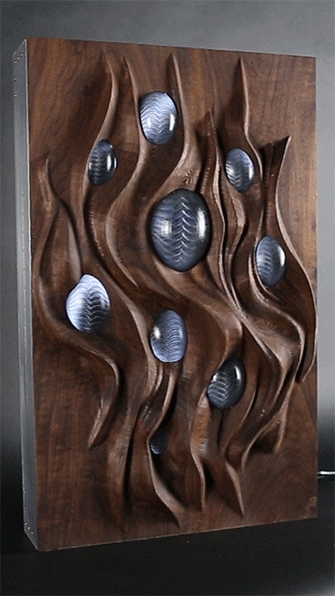Diffusion and Distortion Techniques
Artistic Approaches
Fiber Optics
Ulexite/TV Stone
Computational Caustics
LED through wood veneer
Others
Artistic Approaches
This is a challenging category to compartmentalize, but there is a lot of great work to consider here. Sometimes you don’t need a cutting edge display or experimental hardware to do something new. By placing different optical materials in front of a monitor, projection or LED video wall you can create something that doesn’t feel like a standard display at all. Of course it can be a little more challenging to show sharp coherent images with a techique like this, but sometimes a piece is much more about playing with texture and motion more than legibility.

There are many examples of this kind of work. Mary Franck’s pieces Diffuse Objects and Gilded and Unreal are a great starting point. These pieces combine a standard LCD screen with custom formed materials. The content show on the screen interacts with the materials in a way that gives the light and imagery more physicality and dimension than it would on a flat screen.
Another piece in this area is Lucy Hardcastle’s Qualia. This is a touch sensitive version of a 3D object that has light passing through it. I’m only speculating on how this works, but from the video it looks like it is projection (note DLP projection rainbow bands) from underneath into a 3d form that has been frosted. I suspect the touch sensitivity is done using IR light and a camera in a similar way to rear projection touch tables.
Kimchi and Chips also have an amazing series of pieces that utilize custom optical elements, software and screens - check out their Optical Rail series
Fiber Optics and Acrylic
If you’re not into diffusion and blur, you can can be a more precise with your light redirection techniques by using fiber optic materials. Yeseul Song’s Glow Box is a fabricated object that uses fiber optics and a projector to produce low resolution images that have been bent through the fiber optic cables.
Working with fiber optics can be expanded into longer or larger forms as well. MIT Mobile Experience Lab made something called The Cloud in 2008 that was a large cloud shaped structure that had hundreds of fiber optic strands coming off of it like hairs. Each strand could be individually illuminated and from the video it seems there is an interaction method to let people touch strands and have them respond. Very basic imagery and text could be rendered across the fiber optic strands with what I hope wasn’t an individual LED per strand, but in 2008 that may have been the only option for a shape that unusual.
This technique below uses clear acrylic/3D printed material on top of a standard display to create a sort of volumetric effect using really basic materials.
Ulexite/TV Rock
If strands and pixels aren’t your thing, there is also a material called Ulexite that is essentially a natural fiber optic rock. Also called “TV Rock” this material has a crystal structure that appears to project the image of whatever is on the bottom of it to the top surface. I’ve only seen small pieces of it, but if you had a larger polished piece, you could do some unusual surface mapping effects that would look very different compared to just glass or densely packed fiber optic strands.
Computational Caustics
In another related direction to Ulexite, some researchers are investigating a technique that uses specially formed plastics that geometrically model caustics so that the final material can display a coherent image when light is focused through them in just the right way. Here is some research on this topic.
The company Rayform is offering the creation of these coherent caustics as a service for different applications using a patented process. They allow for the creation of physical things that allow for image creation using either reflection (light bouncing off a material) or refraction (light passing through). The resulting physical elements basically look like wavy plastic or glass, but the magic appears when you shine a light through them. They even have a jewelry line for getting custom reflection messages printed.
Rayform essentially takes a few things into consideration - the position of the source of light (point source is best, but sunlight can work), the size of the refraction surface, and the distance to the "projection surface" where the image shows up. When they take all of these into account, their specialized algorithm can generate a 3D model that can then be used to create a mold for making multiple copies of your intended piece.

Rayform Examples:
Low resolution Diffusion
Finally, there are techniques that are just doing a low resolution diffusion or reflection of light like pixel displays. There are tons of examples of this Jason Eppink’s Pixelator is a piece that co-ops public advertising monitors in NYC and distorts them into more pleasant abstract designs using diffusion and foamcore frames. Jim Campbell’s work has been a great example of this kind of low resolution image making for a while as well.
Wood Veneer and LED
Some companies have explored doing diffusion through very thin wood panels, such as this project from DetaiLED that puts LEDs behind a wood veneer. Something to keep in mind with this approach is the color shifting due to the natural wood, and the loss of light/additional heat - as well as the specialized fabrication to install the very thin wood veneer.

Others
Red Paper Heart's Expression Wall
Last updated
Was this helpful?